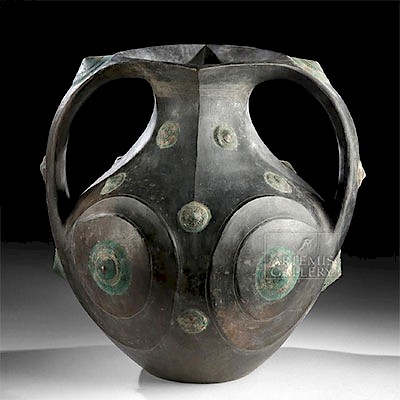Large Mesopotamian Clay Cuneiform Administrative Tablet
Lot 74a
About Seller
Artemis Gallery
686 S Taylor Ave, Ste 106
Louisville, CO 80027
United States
Selling antiquities, ancient and ethnographic art online since 1993, Artemis Gallery specializes in Classical Antiquities (Egyptian, Greek, Roman, Near Eastern), Asian, Pre-Columbian, African / Tribal / Oceanographic art. Our extensive inventory includes pottery, stone, metal, wood, glass and textil...Read more
Estimate:
$6,000 - $8,000
Absentee vs Live bid
Two ways to bid:
- Leave a max absentee bid and the platform will bid on your behalf up to your maximum bid during the live auction.
- Bid live during the auction and your bids will be submitted real-time to the auctioneer.
Bid Increments
| Price | Bid Increment |
|---|---|
| $0 | $25 |
| $300 | $50 |
| $1,000 | $100 |
| $2,000 | $250 |
| $5,000 | $500 |
| $10,000 | $1,000 |
| $20,000 | $2,500 |
| $50,000 | $5,000 |
| $100,000 | $10,000 |
| $200,000 | $20,000 |
About Auction
By Artemis Gallery
Jul 11, 2019
Set Reminder
2019-07-11 10:00:00
2019-07-11 10:00:00
America/New_York
Bidsquare
Bidsquare : Ancient / Ethnographic / Americana
https://www.bidsquare.com/auctions/artemis-gallery/ancient-ethnographic-americana-4246
Discover ancient art from Egypt, Greece, Italy, and the Near East, as well as Asian, Pre-Columbian, Tribal, Fossils and Fine Art. Also featuring a wonderful collection from a prominent New York estate whose owners reside in the Van Wyck family's historic Lloyd Harbor waterfront home. Artemis Gallery info@artemisgallery.com
Discover ancient art from Egypt, Greece, Italy, and the Near East, as well as Asian, Pre-Columbian, Tribal, Fossils and Fine Art. Also featuring a wonderful collection from a prominent New York estate whose owners reside in the Van Wyck family's historic Lloyd Harbor waterfront home. Artemis Gallery info@artemisgallery.com
- Lot Description
Ancient Near East, Mesopotamia, Early Dynastic IIIa to IIIb, ca. 2500 to 2230 BCE. A wonderful and early cuneiform administrative tablet of an ovoid form with lightly-rounded peripheries, a slightly-convex obverse face, and a dramatically-convex verso. Sprawled across the tablet are roughly 132 delineated panels, each containing a record of barley disbursements to several named individuals; however, the names from this period are difficult to read. As the agricultural and trading networks of ancient Mesopotamia grew, farmers, merchants, and rulers realized they needed an effective means of tracking shipments and cargo across vast distances. Their solution, the writing system known as cuneiform, was created by impressing sharpened reeds or sticks into still-wet clay just before firing. Early variations of cuneiform used the rounded end of a stylus to create small holes along with the characters; in time this practice was eventually phased out. Size: 4.25" W x 4.1" H (10.8 cm x 10.4 cm).
A stylistically-similar example of a somewhat larger size hammered for $86,500 at Sotheby's, New York "Egyptian, Classical and Western Asiatic Antiquities" auction (December 8, 2010, lot 84): http://www.sothebys.com/en/auctions/ecatalogue/lot.84.html/2010/egyptian-classical-and-western-asiatic-antiquities-n08688
Provenance: private Colorado, USA collection; ex-private California, USA collection, acquired in 1989
All items legal to buy/sell under U.S. Statute covering cultural patrimony Code 2600, CHAPTER 14, and are guaranteed to be as described or your money back.
A Certificate of Authenticity will accompany all winning bids.
We ship worldwide and handle all shipping in-house for your convenience.
#143812Several areas of repair with small losses and light adhesive residue along break lines. Minor nicks and abrasions to faces and peripheries, with softening to some areas of cuneiform inscription, and encrustations along the verso. Light earthen deposits throughout.Condition
- Shipping Info
-
All shipping is handled in-house for your convenience. Your invoice from Artemis Gallery will include shipping calculation instructions. If in doubt, please inquire BEFORE bidding for estimated shipping costs for individual items.
-
- Buyer's Premium



 EUR
EUR CAD
CAD AUD
AUD GBP
GBP MXN
MXN HKD
HKD CNY
CNY MYR
MYR SEK
SEK SGD
SGD CHF
CHF THB
THB













